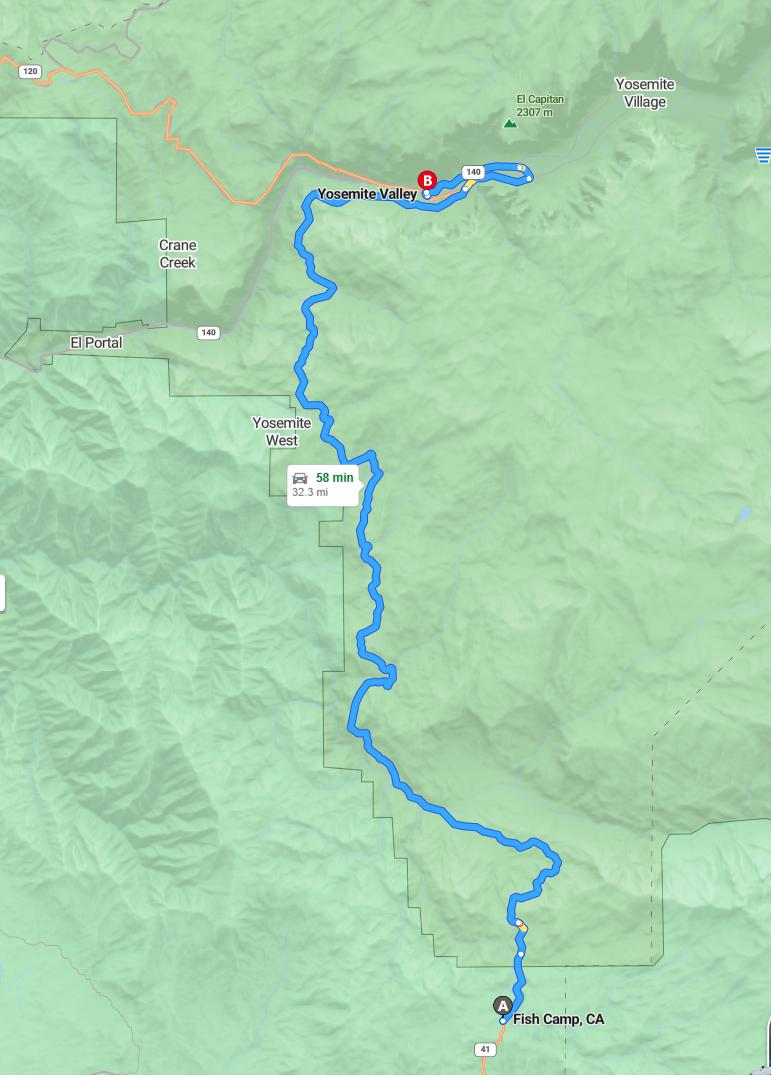Distance and estimated driving time
The drive from Fish Camp to Yosemite Valley via Wawona Road covers approximately 32.3 miles. The estimated travel time is about 1 hour and 58 minutes, providing a scenic route through the stunning landscapes of Yosemite. Travelers can enjoy picturesque views along the way, making the journey part of the overall experience. Planning accordingly ensures a smooth trip, allowing visitors to fully appreciate the natural beauty of the area.
Driving route
Driving from Fish Camp to Yosemite Valley offers a scenic and memorable journey through one of California's most iconic national parks. Starting in Fish Camp, travelers can enjoy the lush beauty of Sierra Nevada forests before heading toward Yosemite West, a charming community nestled within the park's boundaries. The route provides stunning views of granite cliffs, waterfalls, and diverse wildlife, making it an ideal experience for nature enthusiasts. As you approach Yosemite Valley, the breathtaking vistas of El Capitan and Half Dome become prominently visible, showcasing the park's legendary landscapes. This straightforward drive combines convenience with unparalleled natural beauty, ensuring visitors encounter the essence of Yosemite's majestic wilderness.

Best time to travel
The best time to travel from Fish Camp to Yosemite Valley is during the late spring and early fall when the weather is typically mild and the scenery is breathtaking. Visiting in late April to early June offers the advantage of blooming wildflowers and accessible waterfalls, while September and October provide cooler temperatures and less crowded conditions. Summer months, from July to August, are popular but can be crowded and hot, especially at Yosemite Valley. It's advisable to plan your trip outside peak seasons for a more peaceful experience and optimal sightseeing opportunities.
Road conditions and seasonal factors
Driving from Fish Camp to Yosemite Valley typically involves navigating well-maintained roads that are accessible year-round, though seasonal factors can significantly impact travel conditions. During winter months, snow and ice can create hazardous driving conditions, often leading to chain requirements and temporary road closures, especially on higher elevations like Yosemite West. In spring and fall, weather variability may cause wet or slick surfaces, so drivers should exercise caution and check for updated road conditions before departing. Summers usually offer the most favorable driving conditions, with clear roads and minimal weather-related disruptions, making it an ideal time for a scenic journey.
Parking options in Yosemite Valley
Yosemite Valley offers a variety of parking options to accommodate visitors' needs. Upon arrival, visitors can take advantage of several parking areas, including the large Yosemite Valley Parking Area, which is conveniently located near major attractions and trailheads. Additional parking is available at designated areas such as the Ahwahnee Hotel Parking and the Curry Village Parking Lot, providing easy access to popular sites. During peak seasons, parking can fill up quickly, so planning ahead or utilizing the free shuttle service is recommended for a more convenient visit.
Scenic spots along the route
As you drive from Fish Camp to Yosemite Valley, you'll pass through several stunning scenic spots that showcase the area's natural beauty. Starting at Fish Camp, travelers can enjoy picturesque views of lush forests and towering granite peaks. Continuing to Yosemite West, visitors are treated to panoramic vistas of the majestic Sierra Nevada mountains and scenic overlooks that highlight the park's rugged landscape. Finally, arriving at Yosemite Valley, travelers can marvel at iconic landmarks such as El Capitan and Half Dome, surrounded by lush meadows and cascading waterfalls, making this route a truly breathtaking journey for nature enthusiasts.
Local traffic regulations and tips
When driving from Fish Camp to Yosemite Valley, it is important to observe the local traffic regulations, including adhering to posted speed limits, which are typically lower within park areas to ensure safety for visitors and wildlife. Always follow signs indicating park rules, such as restrictions on idling and parking in designated zones, to help preserve the natural environment. Be prepared for variable road conditions, especially during winter months when snow and ice may affect driving; carrying chains is recommended. Additionally, maintaining a respectful and cautious driving style helps ensure a safe and enjoyable visit to Yosemite's breathtaking landscapes.
Vehicle requirements and restrictions
When driving from Fish Camp to Yosemite Valley, vehicles must meet specific requirements and restrictions to ensure safety and preservation of the park. All vehicles should be well-maintained, with functioning brakes, lights, and tires, as the route involves winding roads and varying elevations. Oversized or commercial vehicles may face restrictions or require special permits, especially within designated park areas. Additionally, parking regulations and seasonal closures should be observed to protect park resources and ensure a smooth, enjoyable visit for all travelers.
Dining and lodging options nearby
While traveling from Fish Camp to Yosemite Valley, visitors can enjoy a variety of dining and lodging options along the route. In Fish Camp, there are cozy inns and cafes that provide a convenient start to your journey, offering hearty meals and comfortable accommodations. As you approach Yosemite West, several hotels and lodges offer modern amenities and delicious dining options for travelers seeking comfort and convenience. Upon reaching Yosemite Valley, guests can choose from renowned lodges such as The Ahwahnee and nearby restaurants that showcase local cuisine, ensuring a memorable stay immersed in the park's stunning scenery.
Safety tips for mountain driving
When driving through mountain areas like the route from Fish Camp to Yosemite Valley, it is essential to prioritize safety. Ensure your vehicle is in good condition, with well-maintained brakes and tires suitable for steep and winding roads. Reduce your speed on sharp curves and be cautious of falling rocks or debris, especially after weather events. Additionally, stay alert for changing weather conditions, such as fog or rain, which can reduce visibility and traction, making cautious driving even more important.
